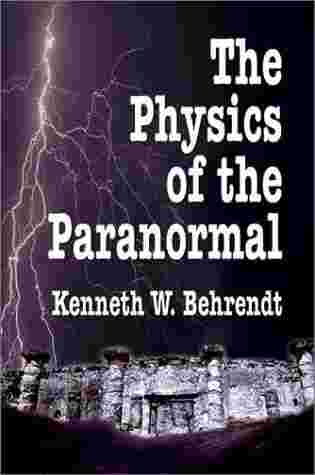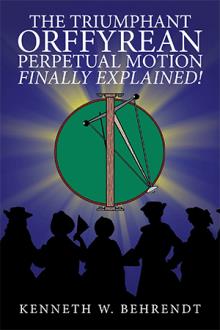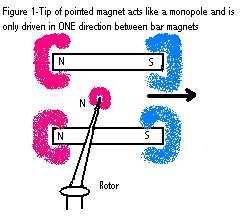|
Explore the Secrets of the Paranormal in:
THE PHYSICS OF THE PARANORMAL |

|
|
Find Answers to the UFO Mystery in:
SECRETS OF UFO TECHNOLOGY |

|
|
Find EVEN MORE Answers to the UFO Mystery in:
THE HOW AND WHY OF UFOS |

|
|
Answers for the MOST serious of ufologists:
THE NEW SCIENCE OF THE UFO |
|
|
Know Tomorrow's Science Today:
ESSAYS FROM THE EDGE OF SCIENCE |

|
|
After Three Centuries, THE Solution:
THE TRIUMPHANT ORFFYREAN PERPETUAL MOTION FINALLY EXPLAINED! |

|
|
Humanity's New Physics Begins Here:
THE COMING ALTERNATIVE SCIENCE REVOLUTION |

|
|
Finally Answers that Make Sense:
Answers to 101 Questions About Extraterrestrial UFOs That THEY Don't Want YOU to Know! |

|
|
Thoughts on Permanent Magnet Motors by Kenneth W. Behrendt |

|
|
We live in a world which, year by year, is becoming more and more concerned about where the energy to power our global civilization will come from as we begin the 21st century. The promises of fission and fusion power that were made in the previous century have not been kept and we have been, more or less, left dependent upon a dwindling supply of fossil fuels whose toxic combustion products are slowly damaging our planet's atmosphere and altering her weather. If ever there was time for a revolution in energy generation to take place, it is now. Yet, the alternatives to fossil fuels have all proven to be plagued with problems.
Alternative energy generation technologies have been shown to work, but are, generally, too expensive and temperamental to meet the growing needs of the world's energy hungry peoples. Conservation programs and improvements in the efficiency of energy usage have helped a little. At least they have pushed the problem of severe fossil fuel scarcity a few years into the future. But, in the final analysis, if Earth's planetary civilization is going to survive and progress, then it is IMPERATIVE that we final some vast new supply of energy which can be easily and abundantly tapped.
For many years, especially in my youth, I realized that the area of alternative sciences that dealt with energy production might provide that vast new supply of energy mankind would eventually need to harness. As readers of my previous article titled "Perpetual Motion Machines ARE Possible!" will recall, I have devoted much time in my life to a search for a device that might be able to deliver virtually unlimited amounts of energy. In pursuit of this end, I apent many hours contemplating, designing, and constructing various devices that I had hoped would be able to provide a steady and reliable supply of "free" energy. My efforts were mostly directed toward the construction of rotating wheels that would use shifting weights within their interiors to provide a continuous torque that could then be used to perform mechanical work or drive electrical generators for the more convenient power of electricity. Unfortunately, ALL of my efforts were futile although I remain, to this day, convinced that it can and HAS been done at least once in the history of this planet.
As I studied the topic of "self motive" power in depth, I became aware that the devices intended to achieve this "Holy Grail" of science and technology fell into several distinction categories.
First, there were the purely mechanical devices like the ones I was pursuing. They utilized various arrangements of weights, springs, and levers in an attempt to produce more energy in operation then they consumed to stay in motion. Next, there were devices in which the attractive and repulsive forces between permanent magnets were intended to maintain the rotation of a shaft or the oscillation of a pendulum or rocking beam. These were followed by machines that it was hoped could use the differences in air or water pressure to provide extractable external energy while the system that produced it continuously restored itself to some initial state. Finally, there was a large category of devices that involved electronic circuitry. These were intended to produce electrical power continuously in excess of a small amount of power that they consumed while in operation. As I and others have noted, the pursuit of these devices seemed to mirror the development of the various engineering sciences.
In my early research into this subject, I did make several occasional attempts at building devices which used permanent magnets to produce continuous power. I did this despite the fact that ALL of my science teachers considered it an impossible feat to accomplish. Their reasoning made "intellectual" sense to me, but somehow I felt at the time that there might be some unique arrangement of magnets that would allow me to overcome their objections. At the time I did not fully realize just how many individuals during the last MILLENIUM had the EXACT same intentions as I did!
Over the years that my serious involvement in the pursuit of a genuine free energy device spanned, I managed to make the acquaintance of several individuals who, like myself, tried inventing various similar devices as a hobby. One day in the early 1980's, I received a telephone call from one of them who was a much older gentleman whom I shall herein refer to by the pseudonym of "Bernard".
When he called, Bernard was quite excited and told me that while he had been perusing a recent issue of a popular magazine for inventors, he came across an advertisement in its classified section that offered plans for sale for a GENUINE free energy device. He was surprised that I had not heard of the new device especially since it was PATENTED!
My curiosity was immediately aroused about the invention, especially since it claimed to produce free energy and had also been granted a patent. The United States Patent Office had stopped issuing such patents at the beginning of the 20th century on the grounds that such a device was physically IMPOSSIBLE! However, there was ONE exception to this rule...the Patent Office would, indeed, grant the patent IF the inventor had a WORKING model of the device! I told Bernard all of this and I could feel his excitement growing even stronger over the phone. At this point we were both convinced that the long search for such a device had ended and that a Golden Age of limitedless power production was about the begin!
Bernard, who lived on a Social Security check and the interest on a modest bank account, decided to order the plans at once despite the fact that they cost about $50. He was eager to build a copy of the invention that he could then proudly display to all of the people who had scoffed at his own attempts to achieve a free energy or "over unity" energy machine during his lifetime. He even hoped that he might be able to improve upon it and get his own patents on the improvements.
About three weeks after our initial conversation about the device, I received another call from Bernard. He had received the plans for the invention and it turned out to be a kind of motor that was powered by permanent magnets. Aside from some of the odd shaped magnets it used, its construction was fairly simple. Bernard, however, wanted to make an EXACT copy of the device and intended to use the services of a local machine shop. They would fabricate all of the parts according to the blue prints Bernard had received and then Bernard would have the pleasure of the final assembly of the motor. He planned to use it to run a small AC generator whose power he would use to operate a bank of lightbulbs. It would be an impressive demonstration of the new technology that would delight all to whom he showed the gadget.
Copying this motor, however, turned out to be a LOT more difficult than either Bernard or I anticipated. The machine shop charged him close to $1500 to make the various metallic parts of the motor which were carefully and precisely cut from stardard steel and aluminum stock. But he considered it a small price to pay to finally be able to prove to himself and his family that what he had pursued for several decades was real.
Finally, after several weeks, the housing and internal metallic components of his device were finished by the machine shop. However, he still had not obained the permanent magnets that were CRITICAL to the device's operation. The plans he purchased said that they could be purchased from a company that the original inventor had worked with when he built his prototype. When Bernard tried to contact the company he learned that they were no longer in business! Bernard then decided to call the inventor and tell him of the problems he was having in obtaining the special magnets. The inventor was surprised to hear the news and told Bernard that he would have to find another company to make the magnets for him.
Since he had already invested almost $1500, Bernard wasted no time calling every magnet supplier he could find in a desperate attempt to find the correct magnets for his copy of the free energy motor. His predicament was made worse by the fact that the magnets, aside from being composed of a VERY expensive rare earth alloy, had to have an odd shaped cross section. After another month of searching, he obtained magnets of the correct material and strength, but then had to return to his local machine shop for more help.
For a hefty price, the machine shop people said that they would try to grind his magnets until they were the correct shape he needed for his motor. This took another month, but the day finally arrived when Bernard's basement shop table was covered with ALL of the parts that the inventor had specified in the blue prints that Bernard had purchased from him almost six months earlier. Each part was a PRECISE duplicate of the ones that went into the original motor and all was ready for assembly. However, the cost to Bernard had been quite high...in fact, the finally price was close to $5000! But, Benard still considered it a bargain. After all, he was now one of the first persons to be part of the revolution in power generation that was about to dawn for humanity.
The next night, before he began the final assembly, Bernard called me to tell me of the various problems that he had to overcome to finally reach the point where his dream of a lifetime was soon to be realized. We chatted for almost an hour long distance and the conversation ended with me offering him my admiration and a confession that I wished that I had been in a financial position to achieve what he was about to achieve.
Another a week went by and one night my phone rang. It was Bernard again, only this time he sounded VERY depressed. He then told me that he had assembled the motor and checked to make sure all of its parts were in their precise positions. Then he manually grasped its output pulley and gave the lubricated and smoothly turning shaft a strong spin to get it started as had been recommended in the plans for the device. The rotor shaft spun flawlessly on its precision bearings and...gradually SLOWED to a stop! He tried again and again only to get the same result...apparently the motor did not work! Bernard disassemblied it and checked the positions and orientations of all of its expensive magnets, but everything was EXACTLY as the plans called for.
The next day Bernard called the inventor of the device and told him of the results. The inventor expressed bewilderment over the outcome and suggested that the problem must be that permanent magnets used were not quite right. Aside from this opinion, the inventor could help him no further.
I asked Bernard during a later phone conversation if the inventor had ever told him that he had a WORKING model of the motor. Bernard said the matter had not come up because he had ASSUMED that with a patent for such a device, that the inventor must have had one. I, too, had assumed that a working prototype existed and that it must have been produced to satisfy the requirements of the the Patent OFfice. However, in later research into the matter, we learned that it is quite possible to get a patent for a perpetual motion machine or any other kind of similar device WITHOUT a working model just so long as one words one's patent application properly. More specifically, one can literally patent ANY unique assemblage of weights, levers, springs, magnets, rotors, or circuits just so long as none of the invention's claims state that it is CREATING a net output of energy during its operation!
Whether or not the inventor ever had a working model of the device which he patented and whose plans he marketed, neither I nor Bernard will ever know. But this bitter experience taught BOTH of us a valuable lesson. Namely that, ultimately, a patent means NOTHING when it comes to determining the functionality of an invention. Based on his sad experience, I would only accept the reality of such a device if I had personally invented it or if another inventor of such a device let me examine, test, disassemble, and reassemble it to PROVE to myself that it was not a fraud. If this was not possible, then I might accept the evaluation of a committee of TRAINED specialists if they verified that the device was genuine.
I would also HIGHLY recommend to others that they likewise adopt such very strict standards when considering such devices. Short of this, one can not really trust any claims made for a free energy device that might appear in a magazine article or on a television news report. In light of the many hoaxes and frauds that have been perpetrated in the free energy field, sadly, one can not trust any claims made by the inventors of such devices. One can only trust their own eyes or the consensus opinion of a GROUP of highly trained specialists who are allowed to test the device with the best equipment available to verify its authenticity. What the skeptics say is true..."Extraordinary claims require extraordinary PROOF".
Bernard passed away several years ago without ever seeing the dawn of the energy revolution he wanted so much to be a part of. The device he attempted to replicate has also faded into obscurity. The true believers in such disappearing inventions will claim that they were suppressed by devious governmental or commercial forces for a variety of reasons. The skeptics will simply point out that they disappeared for one simple reason...they did NOT work! I find myself in the skeptic's camp with regard to the many "revolutionary" devices that have come AND gone over the centuries. They were quickly forgotten when it became obvious to people interested in them that their inventors were more adept at delivering excuses rather than WORKING devices.
With all this said, one might wonder where the author stands with regard to the POSSIBILITY of constructing a WORKING permanent magnet motor. Before I answer that, let me describe some of the actual physics of systems using magnets and then proceed to the implications of this physics.
First and most importantly, the reader should realize that the forces that exist between ANY two magnets regardless of their shapes, strengths, or materials are known in physics as "conservative" forces. This means that magnetic forces do NOT normally violate the First Law of Thermodynamics which states that the amount of energy in a closed system is CONSERVED or remains CONSTANT regardless of what processes are taking place in that closed system (note: a closed system is a portion of the cosmos into which energy can not enter from the outside and from which energy can not leave for the outside).
Now imagine that two magnets are positioned near each other so that their poles ATTRACT each other. If the two magnets are allowed to move toward each other, then they could be rigged up so that in the process they did some work (or released some ENERGY). Perhaps they have strings attached to them so that they both raise a small weight as they slide together and finally make contact.
Let us suppose that it is then decided to separate the two magnets and return them to their ORIGINAL starting positions. To do this a force will have to be applied to both OR either of the magnets. Since forces are being applied to move something through a distance, WORK must now be performed (or ENERGY expended) to separate the magnets.
If careful measurements are made of the amount of energy released as the magnets came together and the amount of energy required to part them and return them to their exact starting positions, then it would be found that the two amounts of energy were EXACTLY EQUAL! The results would be equal regardless of the starting or finishing positions of the two magnets, the orientations of the two magnets, the strengths of the two magnets, or the materials that composed the two magnets. In fact, the results for changing the positions of magnets would be the same even if we had MORE than two magnets to move around!
It is for this reason that ALL attempts to build a permanent magnet motor that uses convential bar or disc shaped magnets are doomed to failure. In my early attempts to create such a device, I would use a rotor that carried one or more magnets and which would rotate inside of an outer stator which had various mangets fixed to it. I could usually get some rotation of the rotor, but it ALWAYS reached an equilibrium position about which it would oscillate before coming to rest.
I once tried a single magnet on a rotor that could turn through 360° inside of a stator that carried dozens of closely spaced magnets arranged to describe a mathematically perfect spiral about the rotor. Interestingly enough, this arrangement actually produced NO motion in the rotor! It was when I saw this that I finally realized that my rotor magnet was actually magnetically coupling with ALL of the magnets in the stator and not just the ones closest to it. I then had to accept the FACT that a permanent magnet motor made with conventional magnets was a physical IMPOSSIBILITY. After all, if it was possible, I eventually reasoned, would not one of the THOUSANDS of other inventors over the centuries have been able to build it?
After giving up on just using permanent magnets to construct their free energy motors, many inventors realize that they might be able to build such a device if they could somehow impose a "shield" of some sort between some of the magnets in their invention when it came time to pull them apart and return them to their starting positions. At first glance this seems like a workable idea. It promises to produce a device which releases energy as unshielded magnets come together, but consumes no energy as they are returned to their starting positions within the motor.
Many permanent magnet motors that use shielding have been invented and...NONE of them works! Most often when two magnets come together within such a device, a metal plate will suddenly be interposed between the magnets in an attempt to cut off the attractive force between them. Designs using this principle range from devices that have swinging magnetic pendulums to rocking magnetic beams. I have even seen some devices that look like magnetic turbines wherein the shielding is wrapped around the trailing sides rotor magnets in an attempt to diminish a counter rotational attractive force as the rotor magnet spins past one of the stator's magnets.
What makes the shielded magnet approach unworkable is the fact that the shielding material is just an easily magnetized sheet of metal alloy which, when brought near a magnet's pole, becomes magnetized itself and turned into a temporary magnet. While the shield may diminish the magnetic interaction between any two magnets in a device, this interaction is then merely replaced by TWO interactions between the magnets and the shield! The end result is that there really is no reduction in the energy REQUIRED to return the two magnets to some starting position.
Realizing the limitations of magnetic shielding, a few inventors have taken the next step in eliminating the internal attractive forces that prevent their device's magnets from returning to their starting positions within the motor without the expenditure of energy. They insert electromagnetic coils inside the device which are activated by electrical current at critical intervals so as to neutralize the attractive forces acting between two separating permanet magnets within the device with their own ELECTROMAGNETIC fields. This approach works! Unfortunately, the motor they finally get running is NOT a free energy device...it is merely an unusual ELECTRIC motor that requires a steady supply of EXTERNAL electrical power.
The problem with such a hybrid device is that the electromagnetic coils it contains require electrical current in order to produce their electromagnetic fields. This current could be produced by the device's rotor as it turns and then operates a small attached electrical generator. However, it seems that no one has ever built such a device wherein the energy required by its electromagnets was LESS than what the motor produced in operation. In fact, in the real world where energy is always wasted by friction and other inefficiencies, these devices ALWAYS produce LESS energy then their internal electromagnets require. As a result, they quickly slow to a standstill after given an electrical "boost" to get them up to operating speed.
With all of the above analysis given for permanent magnet motors, the reader may believe that the author has reached the conclusion that such a free energy device is an impossibility and should not be pursued. However, this is not the case. I do still believe that a permanent magnet motor is possible, but that a design different from those usually tried by inventors is required. In other words, it is time to get out of the rut and pursue designs which are, at least, sound from a theoretical point of view.
In the remainder of this article, I want to give the future permanent magnet motor builders a new direction to move their desings in. This would be the direction that I, myself, would go in IF I was still actively involved in attempting to build a GENUINE permanet magnet motor.
Let me begin by stating that I have noticed that all of the failed permanent magnet motor designs that I have seen have one characteristic in common: they use DIPOLE magnets. That is, the magnets all have both a "north" and a "south" pole. What, I wonder, would be the consequences of using magnets which only have ONE pole? Such a magnet would have EITHER a north or south pole, but not both and would be referred to as a "monopolar magnet" or just a "monopole".
Consider the following scenario. Imagine a large toroidal electromagnet with its wire turns wrapped around a hollow, air-filled toroidal core. The electromagnet is activated by allowing an electrical current to flow through its wire turns and a strong toroidal magnetic field is then established at its core. The magnetic field lines inside of the torus will be concentric with the torus and each line will run completely around the core of the electromagnet.
Now, let us assume that we can somehow introduce a magnetic monopole into the core of the energized toroidal electromagnet. What would the result be? Well, according to electromagnetic theory, the monopole would immediately feel a repulsive force on one side of it and an attractive force on the opposite side of it due to the core magnetic field of the toroidal electromagnet. These unbalanced forces would then cause the monopole to move rapidly around the hollow core of torus and the monopole's motion WOULD NEVER CEASE! In other words, this arrangement would actually be a form of perpetual motion. If it was possible to somehow connect the monopole to a generator outside of the torus, then this system would CONTINUOUSLY produce free electrical energy. I believe that the only way to explain where this free energy came from would be to assume that in the process of generating it, the rest mass of the monopole magnet was slowly being converted into the mechanical energy that drove the generator.
Quite unfortunately, however, magnetic monopoles are only THEORETICAL abstractions...they do not exist in the real world. But, I believe that it is possible to simulate them with a permanent magnet. Imagine that we could take a small ALNICO bar magnet and somehow make it as soft as putty. Now imagine that we were able to stretch out our putty magnet until it was as long and thin as a stand of spaghetti. If we were then to sharpen each end and again restore it to its original alloy hardness, we would notice that each end of our strand would have the properties of a monopole. The north pole end would be a point that EMITTED magnetic field lines in a RADIAL pattern about itself and the south pole end would, similarly, be a point into which magnetic lines of force could be envisioned to be ENTERING or converging in a radial pattern.
Since we want our permanent magnet motor to be purely mechanical, we need to find a substitute for the previously mentioned toroidal electromagnet. We can roughly simulate the core magnetic field in a SECTION of the torus by simply bringing two bar magnets near to each other with their north and south poles in opposition. Thus, the two bar magnets will be repelling each other and magnetic field lines will "leave" their north poles, travel in parallel lines in the space BETWEEN the bar magnets, and then split into two bundles that will "enter" the two south poles of the bar magnets. It is, however, CRITICAL that the two bar magnets not be brought too close together or they will begin to behave like a SINGLE bar magnet and there will be very little magnetic field in the space between them.
Figure 1 below shows a SECTION of a POSSIBLE permanent magnet motor that would use the magnetic monopole motor principle to produce continuous motion in a rotor. The figure shows a very slender magnet with its SOUTH pole attached to an easily moved rotor. The pointed N0RTH pole of the slender magnet can then freely swing so that it moves EXACTLY between two bar magnets and along their lengths.

As the rotor turns to the right in the figure, the north pole tip of the long slender magnet will approach the beginning of the gap between the two north poles of the bar magnets. Rather than being repelled by the two north poles of the bar magnets, however, the pointed magnetized tip of the slender magnet will act like a north magnetic monopole. IF the tip of the slender magnet travels EXACTLY between the two north poles of the bar magnets, then it will actually feel an ATTRACTIVE force that will draw it into the space between the two bar magnets. Once in the space between the two bar magnets, the tip of the slender magnet will continuously feel a force that moves it toward the ends of the bar magnets that have their south poles. As the slender magnet's tip continues to move to the right, it will eventually exit the space between the two bar magnets. However, because it is acting like a magnetic monopole, the tip of the slender magnet will not be attracted back toward the two south poles of the bar magnets that it leaves behind it. In short, as long as the tip of the slender magnet is near or inside of the space between the two bar magnets, it will feel ONLY a force moving it to the right.
At first glace this arrangement of magnets may appear to be unworkable and this will be the case IF the two bar magnets are spaced too closely together. When the space between the bar magnets is carefully adjusted, then the effect will be as though the tip of the slender magnet, when brought near the north pole side of the gap between the bar magnets, was suddenly caught in a tiny wind tunnel. The force it feels will quickly propel it out and AWAY from the south pole side of the gap.
The implications of this effect for the permanent magnet motor designer / builder should now be obvious. For example, a simple device using this effect might consist of FOUR sets of separated bar magnets arranged at 90 degree intervals around a circle. These sets of magnets would form a simple stator. To increase torque, one would use FOUR slender magnets that would all have their south magnetic poles attaced to the central rotor shaft. Once in motion, this simple little device should continue to spin indefinitely as it converts the rest mass of the slender magnets directly into mechanical energy.
From my early study of the various attempts to produce a magnetic perpetual motion machine over the last millenium, I can also say that the above design MAY already have been constructed to produce a WORKING model! The details of the story are somewhat vague, but I will recount them here for the occasional researcher that may wish to delve further into this subject.
In the early 19th century there was an uneducated Scottish shoemaker named Spence (I think his first name was John) who, as a child, had developed a fascination with all types of magnets. When only an adolescent, he managed to build rocking beam device which used permanet magnets as its sole source of power. After this, he brought out another model which used a swinging pendulum to operate. In both models, he had solved the problem of using shields to cut off attractive magnetic fields when the permanent magnets in the devices returned to their starting positions. He claimed to have a black substance which he had developed which could instantly stop a magnetic field, yet was NOT itself magnetized in the process!
Slowly his fame as an ingenious inventor spread throughout Scotland and it was not long before he came to the attention of some professors at the famous Edinburgh University. They, of course, decided, without even examining his devices, that they must all be fraudulent. However, they did invite him to come to the University to demonstrate his inventions so that they could see exactly what he had.
Several years passed before Spence was able to make the trip to the university. When he finally arrived, he is said to have done so while riding in a small horseless carriage that he had built. It was just large enough to hold two people and he offered to take all the professors who wished to try it for a ride. The important detail of this little story is that the carriage Spence drove the professors around the grounds of the school in was powered solely by a rotory permanet magnetic motor that the shoemaker had constructed. This motor had only ONE moving part...its rotor. One by one the learned men of science took a ride in Spence's carriage and were totally bewildered as to how it was propelled. The physics they knew said that it was impossible, yet they could not doubt the evidence their own eyes. Spence at all times tried to answer their countless questions, but he was an uneducated country fellow who had developed his own language to describe magnetic effects. Unfortunately, his explanation of how the motive power source in his carriage operated was totally unintelligible to the professors.
Spence was later offered huge amounts of money for the secret to his devices and to the formula for his black substance magnetic shield. However, he had no particular interest in wealth and seemed to more enjoy mystifying people with his marvelous devices.
Spence was a solitary person and had few friends. As another man in the prior century had been to gravity driven machines (see the author's article titled "Perpetual Motion Machines ARE Possible!"), Spence, in his century, was probably the world's leading expert on magnetic science although all of his knowledge was of an instinctual nature gathered from much trial and error. Eventually, as he got older, he began to have health problems and was no longer able to construct his permanent magnet motors.
On his death bed, Spence entrusted a small box to one of his few friends and asked him to open it someday after he had died. Spence told the younger man that it contained something that he had built when he was a young person and just starting to experiment with magnets. The friend agreed to keep the box in his house, but eventually forgot where he had placed it.
Approximately twenty years after Spence's death, the friend found the small box that had been entrusted to him. He opened it to find that it contained a most unusual device. The box contained the brass balance wheel mounted in a pocket watch from which the hairspring, pallet lever, and remaining movement had been removed. On the balance wheel a small iron nail had been mounted so that its head was near the staff of the balance wheel and its sharp tip was pointing directly away from the staff and out over the rim of the balance wheel. This balance wheel and the nail it carried could swing freely through 360o of motion. Near these, a small horseshoe-shaped magnet had been fixed in place that had a small block of Spence's secret black shielding material inserted between its poles.
Upon opening the small box, Spence's friend noted that the balance wheel was rapidly spinning. When he stopped it with his finger, it would immediately begin spinning again when released. The friend then decided to dissemble the balance wheel assembly with the intention of cleaning and relubricating its ruby jewel bearings. When this was done, he noticed that the jewels had been badly worn despite their prior lubrication. This indicated that the device must have been in continuous rotation for DECADES! When it was again reassembled after servicing, the balance wheel immediately resumed its rapid spinning motion.
Like many such devices which may have been genuine, Spence's early permanent magnet motor has been lost and never again duplicated. From its description, I am convinced that it was a simple, WORKING monopole motor. Hopefully, some day soon some VERY lucky and gifted inventor will be able to reproduce it...
(Note: this article completed January 18th, 2005)
|
|
|
|
|
|
|
HOME
|
|
COSMIC VAULT GIFT SHOP
|
|